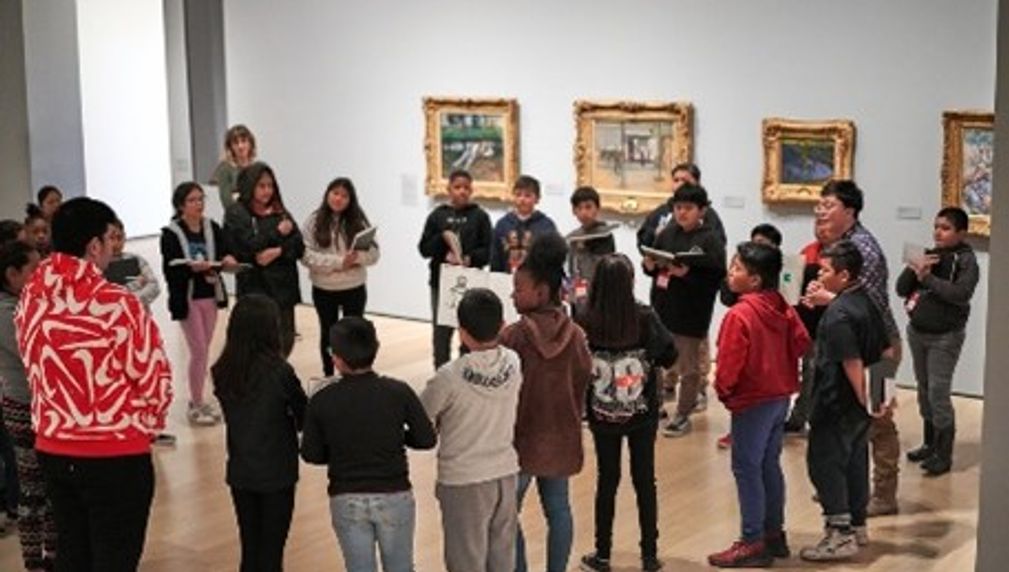Hammer Museum K-12 school visits
A grant from LA2050 will support free K-12 school tours for the 2024-2025 school year, including STEAM education tours of the Hammer’s PST ART: Art & Science Collide exhibition, Breath(e): Toward Climate Change and Social Justice. Tours are led by UCLA student educators and supplemented with additional resources for learning with art that are provided to class teachers. The Hammer seeks to expand this program by providing bus funding to Los Angeles-based Title I schools, who may not have the funds for transportation to the museum.

What is the primary issue area that your application will impact?
K-12 STEAM education
In what stage of innovation is this project, program, or initiative?
Expand existing project, program, or initiative (expanding and continuing ongoing, successful work)
What is your understanding of the issue that you are seeking to address?
Despite the role of the arts in distinguishing Los Angeles as one of the largest cultural centers in the world, many residents have limited access cultural institutions. In 2020, researchers from SRI Education, conducted a comprehensive study on arts education in California’s K-12 public schools. Results revealed that schools fall short of state goals for arts education, with only 11% offering lessons in the 4 arts disciplines required by California policy. The study recognized patterns of inequality, in which schools serving children from low-income households provide less access to arts programs and resources like supplies and equipment.
The Hammer partners directly with schools, particularly Title I schools and those in under-served neighborhoods that lack access to arts education, to alleviate this shortfall and encourage interdisciplinary learning opportunities through art. All academic programs are offered free of charge, ensuring that they are accessible for all participants.
Describe the project, program, or initiative this grant will support to address the issue.
K-12 tours invite teachers and students to discover the power of art through close looking, critical thinking, and inquiry-based conversations. Tours (offered in English and Spanish) include an hour-long session with an educator and focus on one exhibition, or 3-4 artworks. The exhibition this fall, Breath(e): Toward Climate and Social Justice, will incorporate STEAM methodology by introducing students to environmental art and technologies that address the climate crisis. Following tours, classes are encouraged to explore the museum, including the Sculpture Garden on UCLA’s campus.
Visiting classes and teachers are also given guides for engaging with art. Designed to amplify the impact of a tour, each guide contains discussion prompts to be used during the visit, in preparation, and after the visit, which extends student learning in the classroom.
Another critical element of K-12 school visits are the student educators that lead the tours. The Hammer employs UCLA students from diverse disciplines as student educators. In this role, educators participate in a week-long course and biweekly training sessions, which provide workplace readiness skills and professional development. The Hammer welcomes over 1,600 students each year. The Hammer seeks to grow the program to welcome more classes from Title I schools by reserving a portion of the project budget for bus expenses, which will eliminate the financial burden to those who lack the funds to pay for transportation.
Describe how Los Angeles County will be different if your work is successful.
According to the NCES Early Childhood Longitudinal Study, children who visit museums at an early age have higher achievements in reading, math, and science. Behavioral studies also demonstrate the benefits of arts exposure with regards to cognitive, social, and emotional health. The American Academy of Arts & Sciences 2021 Commission on the Arts’ Report states that arts education gives students skills, such as observation, problem solving, innovation, and critical thinking, and generate tools that will serve them throughout their lives. The Commission recommended the inclusion of arts-based curriculum in every child’s education, and specifically calls out engagement with local museums as a successful approach. The Hammer’s K-12 school tours explore art and ideas through interdisciplinary conversations and inquiry. They build visual literacy skills, communication, understanding and other essential skills, for the benefit of students, and ultimately the community of Los Angeles
What evidence do you have that this project, program, or initiative is or will be successful, and how will you define and measure success?
The Hammer’s Academic Programs increase museum literacy, communication skills, and career readiness. Students gain observation and evidence-based reasoning skills that enable them to identify and apply personal, curricular, and social themes and concepts in a variety of artworks and art forms. Teachers gain new strategies and materials for their teaching “toolkits”.
In the 2023-2024 school year, the Hammer contracted an outside research and evaluation specialist to measure K-12 tour outcomes. The consultant observed tours, developed a quantitative system for tracking proficiencies practiced on tours, and created a scaffolding for mapping skills to K-12 anchor standards. Hammer staff also conducted interviews and surveyed K-12 teachers for qualitative data and feedback. This process will continue for the 2024-2025 school year. The Academic Programs team will also form a teacher advisory council to ensure that teachers’ needs are centered as the K-12 tour program expands and develops.
Approximately how many people will be impacted by this project, program, or initiative?
Direct Impact: 1,600.0
Indirect Impact: 15,000.0